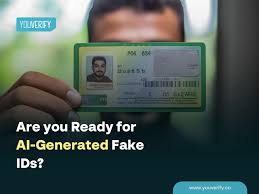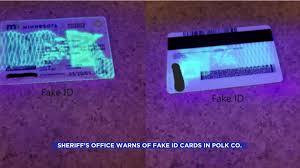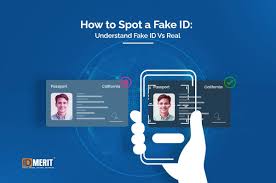Realistic ID Cards
Introduction: The Growing Need for Secure, Realistic ID Cards
Identity verification has long been a cornerstone of security in various industries, from banking and travel to education and government services. In an age where digital solutions dominate, physical identity cards remain one of the most trusted methods of verifying someone's identity. However, as technology has advanced, so too have the capabilities of counterfeiters, making it increasingly difficult to distinguish between genuine and fake ID cards.
This is where "realistic ID cards" come into play. They represent the perfect blend of technology and security, offering a higher level of authenticity than traditional ID cards. Realistic ID cards are designed to not only look like real identification but to feel and act like them as well. These cards are often equipped with features like holograms, watermarks, and embedded security chips to ensure that they cannot be easily replicated.
In this article, we will explore the concept of realistic ID cards in detail—examining their features, benefits, market trends, target audiences, and more. By the end, you’ll have a comprehensive understanding of how these advanced ID cards are reshaping identity verification practices and why they are quickly becoming the preferred choice for businesses and institutions worldwide.
1. What Are Realistic ID Cards?
Realistic ID cards are advanced identification cards that are designed to look and feel like government-issued IDs, such as driver’s licenses or passports. Unlike traditional plastic cards or paper-based IDs, realistic ID cards are created using high-quality materials and are embedded with sophisticated security features that make them almost indistinguishable from the real thing. These security features are specifically crafted to prevent counterfeiting and unauthorized replication.
Some of the key characteristics of realistic ID cards include:
- High-Resolution Graphics: Realistic ID cards feature crisp, clear images and graphics, often using color and shading techniques that are difficult to replicate.
- Holograms and Watermarks: Embedded holograms or watermarks that are visible under specific light conditions serve as key security features.
- Microtext and UV Printing: Fine, often invisible text or patterns that can only be seen under special lighting conditions (such as ultraviolet light) are commonly used for added security.
- Barcodes or QR Codes: These are often used to provide digital verification and enhance the card's functionality.
- RFID Chips or Smart Chips: For advanced identification and access control systems, realistic ID cards may also come equipped with embedded RFID or smart chips.
2. Key Features of Realistic ID Cards
Realistic ID cards incorporate several features that not only make them look authentic but also provide added security, functionality, and convenience. Let’s take a closer look at these features:
2.1 Advanced Printing Technology
One of the most important factors in creating a realistic ID card is the quality of printing. Realistic ID cards are produced using high-end printing technology such as offset printing or laser engraving. These methods ensure that the text, images, and logos on the card are sharp, clear, and resistant to fading over time.
2.2 Security Features
- Holograms: One of the most difficult-to-replicate features on a realistic ID card, holograms offer a layer of security that makes counterfeiting nearly impossible. These three-dimensional images change depending on the angle of light and are commonly seen on government-issued IDs.
- Watermarks: Just like banknotes, many realistic ID cards are embedded with watermarks that are difficult to duplicate. These watermarks are often only visible under certain conditions, such as when viewed at an angle or under UV light.
- UV Printing: Invisible ink or UV printing is often used to include hidden details such as microtext, logos, or patterns that can only be seen under a UV light source. This makes it extremely difficult for counterfeiters to replicate without the proper technology.
2.3 Durability
Realistic ID cards are typically made from durable materials like PVC (Polyvinyl Chloride) or composite cards that are more resistant to wear and tear than traditional paper-based IDs. They are also resistant to fading from sunlight, handling, or moisture, ensuring that the card remains legible and intact over time.
2.4 Customization Options
Realistic ID cards can be highly customized to suit specific needs. Whether you’re creating ID cards for employees, students, or members, customization can include:
- Logos and branding
- Names and photos
- Employee numbers or student IDs
- Access permissions (e.g., building access, restricted areas)
- Personalized colors or design elements
This flexibility makes realistic ID cards ideal for a wide range of industries and use cases.
3. The Market for Realistic ID Cards: An Overview
As the need for secure identification continues to grow, the market for realistic ID cards has expanded significantly. From government institutions to private businesses, organizations are adopting these high-tech cards to improve security, streamline access control, and prevent fraud.
3.1 Industry Applications
Realistic ID cards find applications in numerous sectors, including:
- Government and Law Enforcement: Realistic ID cards are often used for official documentation, such as driver’s licenses, national ID cards, and law enforcement badges. These cards help ensure that only authorized individuals have access to sensitive resources or information.
- Corporate and Workplace Security: Many organizations issue realistic ID cards to employees to manage access to restricted areas, track work hours, and even monitor employee behavior.
- Healthcare: Hospitals and healthcare providers use realistic ID cards to verify patient identities, control access to medical records, and ensure that only authorized staff are allowed in specific areas.
- Education: Schools, colleges, and universities often issue ID cards to students, which serve as both identification and access control tools for campus facilities.
- Hospitality and Tourism: Realistic ID cards are also used in hotels, resorts, and airports to manage guest identities and access to facilities or services.
3.2 Market Growth and Demand
The market for realistic ID cards is expected to continue growing, driven by factors such as the increasing need for security, advancements in printing and RFID technology, and a growing demand for anti-counterfeiting solutions. Additionally, the rise in identity theft and fraud across sectors is prompting businesses and government agencies to invest in more secure and effective identity verification solutions.
According to market research, the global ID card printer market alone is projected to grow at a compound annual growth rate (CAGR) of 5.5% from 2021 to 2028, with realistic ID cards playing a significant role in this growth.
4. Target Audience for Realistic ID Cards
The target audience for realistic ID cards spans multiple industries and sectors. However, some of the key groups include:
4.1 Corporations and Businesses
Businesses looking to manage employee identification, access control, and time-tracking systems are key consumers of realistic ID cards. Whether it’s to enhance security or improve efficiency, companies can benefit from the reliable features offered by these advanced cards.
4.2 Educational Institutions
Schools, universities, and training centers need reliable ID cards for students and staff. Realistic ID cards help prevent unauthorized access to campuses and facilities, while also offering a convenient way for students to access resources and services.
4.3 Government and Public Sector
Government agencies and public institutions rely on secure and verifiable identification to prevent fraud and ensure safety. Realistic ID cards are ideal for issuing national IDs, voter IDs, passports, and law enforcement badges.
4.4 Security Services
Security agencies, both private and public, use realistic ID cards as part of their identification and access control systems. From security badges to ID cards for contractors or visitors, realistic ID cards help ensure that only authorized individuals have access to certain areas.
4.5 Healthcare Providers
Hospitals and medical centers need to ensure patient safety and privacy while also managing staff access to restricted areas. Realistic ID cards serve both these purposes by offering secure identity verification solutions.
5. The Future of Realistic ID Cards: Trends and Innovations
As technology continues to evolve, the features and functionality of realistic ID cards are expected to become even more advanced. Some trends and innovations that are likely to shape the future of realistic ID cards include:
5.1 Integration with Digital Systems
The future of ID cards is likely to involve more integration with digital systems. For example, realistic ID cards might incorporate digital credentials that can be easily verified using smartphones or other mobile devices. This could enable users to access secure systems or buildings with just a scan of their card or phone.
5.2 Biometric Integration
With the increasing focus on biometric authentication, future realistic ID cards may integrate biometric features such as fingerprint recognition, facial recognition, or even retinal scans. These features would offer an extra layer of security and ensure that only the cardholder can use their ID.
5.3 Environmentally Friendly Materials
As sustainability becomes a top priority for many industries, manufacturers may begin to focus on creating eco-friendly ID cards using recycled or biodegradable materials, reducing the environmental impact of producing plastic-based IDs.
6. Conclusion: Why Realistic ID Cards are Essential for Modern Security Needs
Realistic ID cards represent a significant advancement in the field of identification, combining high-quality design with cutting-edge security features to prevent fraud and improve identity verification processes. Their applications across various industries—government, corporate, healthcare, and education—highlight their importance in today’s increasingly security-conscious world.
As the demand for secure identification continues to rise, realistic ID cards are set to play an even more central role in helping organizations protect their assets, verify identities, and prevent unauthorized access. Businesses and institutions that invest in these advanced identification solutions will not only enhance their security but also streamline their operations, improve efficiency, and build greater trust with customers, employees, and stakeholders.
 fake ID buying guide
fake ID buying guide
 fake ID buying guide
fake ID buying guide
 scannable fake ID
scannable fake ID
 scannable fake ID
scannable fake ID
 Arizona novelty ID
Arizona novelty ID
 Arizona novelty ID
Arizona novelty ID
 Realistic ID Cards
Realistic ID Cards
 Realistic ID Cards
Realistic ID Cards
